Spatial Association and Quantitative Attribution of Regional Ecological Risk: A Case Study of Guangxi, China
Abstract
1. Introduction
2. Materials and Methods
2.1. Study Area
2.2. Data Source
2.3. RERA Indicator System Establishment
2.4. Regional Ecological Risk Calculation
2.4.1. Production-Living-Ecology Land Use Function Valuation
2.4.2. Risk Source Intensity Calculation
2.4.3. Eco-Environmental Vulnerability Calculation
2.4.4. Final Regional Ecological Risk Calculation
2.5. Spatial Autocorrelation Analysis
2.6. Geographical Detection Analysis
3. Results
3.1. Regional Ecological Risk Calculation Result
3.1.1. Ecological Risk Source Intensity
3.1.2. Ecological Risk Receptor Capital
3.1.3. Eco-Environmental Vulnerability
3.1.4. Final Regional Ecological Risk
3.2. Spatial Autocorrelation Feature
3.3. Geographical Detection Result
3.4. Bivariate Local Spatial Autocorrelation Analysis
4. Discussion
4.1. The Advancement of the Research and Further Improvements Needed in the Future
4.2. Key Points and Effective Countermeasures for KRD Prevention and Cure
5. Conclusions
Funding
Institutional Review Board Statement
Informed Consent Statement
Data Availability Statement
Conflicts of Interest
References
- Ghehi, N.K.; MalekMohammadi, B.; Jafari, H. Integrating habitat risk assessment and connectivity analysis in ranking habitat patches for conservation in protected areas. J. Nat. Conserv. 2020, 56, 125867. [Google Scholar] [CrossRef]
- Malekmohammadi, B.; Blouchi, L.R. Ecological risk assessment of wetland ecosystems using Multi Criteria Decision Making and Geographic Information System. Ecol. Indic. 2014, 41, 133–144. [Google Scholar] [CrossRef]
- Wang, H.; Song, C.; Song, K. Regional ecological risk assessment of wetlands in the Sanjiang Plain with respect to human disturbance. Sustainability 2020, 12, 1947. [Google Scholar] [CrossRef]
- Zhao, H.; Zhu, T.; Luo, X.; Niu, M.; Zhang, L.; Gu, B. Regional ecological risk assessment of chemical industry stress under China’s coastal development strategy. J. Clean. Prod. 2022, 375, 134085. [Google Scholar] [CrossRef]
- Yu, W.; Zhang, L.; Ricci, P.F.; Chen, B.; Huang, H. Coastal ecological risk assessment in regional scale: Application of the relative risk model to Xiamen Bay, China. Ocean Coast. Manag. 2015, 108, 131–139. [Google Scholar] [CrossRef]
- Hunsaker, C.; Graham, R.; Suter, G.; O’Nell, R.; Branthouse, L.; Gardner, R. Assessing ecological risk on regional scale. Environ. Manag. 1990, 14, 325–332. [Google Scholar] [CrossRef]
- Ju, H.; Niu, C.; Zhang, S.; Jiang, W.; Zhang, Z.; Zhang, X.; Yang, Z.; Cui, Y. Spatiotemporal patterns and modifiable areal unit problems of the landscape ecological risk in coastal areas: A case study of the Shandong Peninsula, China. J. Clean. Prod. 2021, 310, 127522. [Google Scholar] [CrossRef]
- Xie, H.; Wen, J.; Chen, Q.; Wu, Q. Evaluating the landscape ecological risk based on GIS: A case-study in the Poyang Lake region of China. Land Degrad. Dev. 2021, 32, 1–13. [Google Scholar] [CrossRef]
- Xu, X.; Xu, L.; Yan, L.; Ma, L.; Lu, Y. Integrated regional ecological risk assessment of multi-ecosystems under multi-disasters: A case study of China. Environ. Earth Sci. 2015, 74, 747–758. [Google Scholar] [CrossRef]
- Landis, W.G.; Wiegers, J.A. Design considerations and a suggested approach for regional and comparative ecological risk assessment. Hum. Ecol. Risk Assess. Int. J. 1997, 3, 287–297. [Google Scholar] [CrossRef]
- Liu, X.; Chen, H. Regional assessment on ecological risk of ecosystems under natural hazards: An application in Guangdong Province (SE China). Nat. Hazards 2020, 100, 205–229. [Google Scholar] [CrossRef]
- Wang, H. Regional ecological risk assessment of the Yellow River Delta High-efficiency Eco-economic Zone, China, with respect to human production–living disturbance. Environ. Dev. Sustain. 2025, 27, 2581–2609. [Google Scholar] [CrossRef]
- Landis, W.G.; Wiegers, J.K. Ten years of the relative risk model and regional scale ecological risk assessment. Hum. Ecol. Risk Assess. Int. J. 2007, 13, 25–38. [Google Scholar] [CrossRef]
- Anderson, S.; Landis, W. A Pilot application of regional scale risk assessment to the forestry management of the Upper Grande Ronde Watershed, Oregon. Hum. Ecol. Risk Assess. 2012, 18, 705–732. [Google Scholar] [CrossRef]
- Heenkenda, M.K.; Bartolo, R. Regional ecological risk assessment using a relative risk model: A case study of the Darwin Harbour, Darwin, Australia. Hum. Ecol. Risk Assess. Int. J. 2016, 22, 401–423. [Google Scholar] [CrossRef]
- Munns, W. Assessing risks to wildlife populations from multiple stressors: Overview of the problem and research needs. Ecol. Soc. 2006, 11, 23. [Google Scholar] [CrossRef]
- Schleier, J.J., III; Sing, S.E.; Peterson, R.K.D. Regional ecological risk assessment for the introduction of Gambusia affinis (western mosquitofish) into Montana watersheds. Biol. Invasions 2008, 10, 1277–1287. [Google Scholar] [CrossRef]
- Vezi, M.; Downs, C.; Wepener, V.; O’Brien, G. Application of the relative risk model for evaluation of ecological risk in selected river dominated estuaries in KwaZulu-Natal, South Africa. Ocean Coast. Manag. 2020, 185, 105035. [Google Scholar] [CrossRef]
- Wang, H. Regional ecological risk assessment through the application of production-living-ecology land use function indicators: A case study of the eco-economic zone of Yellow River Delta. Environ. Sci. Pollut. Res. 2024, 31, 50967–50982. [Google Scholar] [CrossRef]
- Anselin, L. Local indicators of spatial association-LISA. Geogr. Anal. 1995, 27, 93–115. [Google Scholar] [CrossRef]
- Xie, H.; Wang, P.; Huang, H. Ecological risk assessment of land use change in the Poyang Lake Eco-economic Zone, China. Int. J. Environ. Res. Public Health 2013, 10, 328–346. [Google Scholar] [CrossRef]
- Gan, L.; Halik, U.; Shi, L.; Welp, M. Ecological risk assessment and multi-scenario dynamic prediction of the arid oasis cities in northwest China from 1990 to 2030. Stoch. Environ. Res. Risk Assess. 2023, 37, 3099–3115. [Google Scholar] [CrossRef]
- Liu, C.; Zhang, K.; Liu, J. A long-term site study for the ecological risk migration of landscapes and its driving forces in the Sanjiang Plain from 1976 to 2013. Acta Ecol. Sin. 2018, 38, 3729–3740. [Google Scholar] [CrossRef]
- Liu, H.; Wang, R.; Sun, H.; Cao, W.; Song, J.; Zhang, X.; Wen, L.; Zhuo, Y.; Wang, L.; Liu, T. Spatiotemporal evolution and driving forces of ecosystem service value and ecological risk in the Ulan Buh Desert. Front. Environ. Sci. 2023, 10, 1053797. [Google Scholar] [CrossRef]
- Gao, J.; Zhang, Y.; Zuo, L. The optimal explanatory power of soil erosion and water yield in karst mountainous areas. J. Geogr. Sci. 2023, 33, 2077–2093. [Google Scholar] [CrossRef]
- Lu, Q.; Fan, H.; Zhang, F.; Chen, W.; Xia, Y.; Yan, B. The dominant role of human activity intensity in spatial pattern of ecosystem health in the Poyang Lake ecological economic zone. Ecol. Indic. 2024, 166, 112347. [Google Scholar] [CrossRef]
- Zhang, Z.; Hou, Y.; Sun, H.; Guo, S. Study on the evaluation of the spatial function and coordination relationship of the territorial “production-living-ecological” spaces at the township-street scale. J. Nat. Resour. 2022, 37, 2898–2914. [Google Scholar] [CrossRef]
- Liu, Y.; Wang, J.; Deng, X. Rocky land desertification and its driving forces in the karst areas of rural Guangxi, Southwest China. J. Mt. Sci. 2008, 5, 350–357. [Google Scholar] [CrossRef]
- Xu, G.; Xiong, K.; Shu, T.; Shi, Y.; Chen, L.; Zheng, L.; Fan, H.; Zhao, Z.; Yang, Z. Bundling evaluating changes in ecosystem service under karst rocky desertification restoration: Projects a case study of Huajiang-Guanling, Guizhou province, Southwest China. Environ. Earth Sci. 2022, 81, 302. [Google Scholar] [CrossRef]
- Yang, Q.; Wang, K.; Zhang, C.; Yue, Y.; Tian, R.; Fan, F. Spatio-temporal evolution of rocky desertification and its driving forces in karst areas of Northwestern Guangxi, China. Environ. Earth Sci. 2011, 64, 383–393. [Google Scholar] [CrossRef]
- Yang, Q.; Jiang, Z.; Yuan, D.; Ma, Z.; Xie, Y. Temporal and spatial changes of karst rocky desertification in ecological reconstruction region of Southwest China. Environ. Earth Sci. 2014, 72, 4483–4489. [Google Scholar] [CrossRef]
- Cui, X.; Xu, N.; Chen, W.; Wang, G.; Liang, J.; Pan, S.; Duan, B. Spatio-temporal variation and influencing factors of the coupling coordination degree of production-living-ecological space in China. Int. J. Environ. Res. Public Health 2022, 19, 10370. [Google Scholar] [CrossRef] [PubMed]
- Fu, J.; Zhang, S. Functional assessment and coordination characteristics of production, living, ecological function—A case study of Henan Province, China. Int. J. Environ. Res. Public Health 2021, 18, 8051. [Google Scholar] [CrossRef]
- Wang, A.; Liao, X.; Tong, Z.; Du, W.; Zhang, J.; Liu, X.; Liu, M. Spatial-temporal dynamic evaluation of the ecosystem service value from the perspective of “production-living-ecological” spaces: A case study in Dongliao River Basin, China. J. Clean. Prod. 2022, 333, 130218. [Google Scholar] [CrossRef]
- Wu, A. Classification evaluation and pattern evolution of production-living-ecology spaces in Beijing-Tianjin-Hebei Region. Chin. J. Agric. Resour. Reg. Plan. 2019, 40, 237–242. [Google Scholar]
- Chen, X. Study on evaluation and regionalization of agroecological vulnerability in Guangxi. Chin. J. Agric. Resour. Reg. Plan. 2020, 41, 212–219. [Google Scholar]
- Yao, W.; Zhou, S.; Chen, Z.; Tang, Q.; Zhou, X.; Huang, W.; Wang, G.; Wei, X.; Zhou, Q. Butterfly community structure and diversity in Guangxi Mao’ershan National Nature Reserve. Guangxi Sci. 2024, 31, 1089–1100. [Google Scholar]
- Zhang, M.; Zhang, C.; Wang, K.; Yue, Y.; Qi, X.; Fan, F. Spatiotemporal variation of karst ecosystem service values and its correlation with environmental factors in Northwest Guangxi, China. Environ. Manag. 2011, 48, 933–944. [Google Scholar] [CrossRef]
- Xie, Y.; Lin, S.; Tu, S.; Lu, Y.; Pan, X. Identification and spatial pattern of multidimensional poverty measurement in karst rocky desertification regions. Trans. Chin. Soc. Agric. Eng. 2020, 36, 276–285. [Google Scholar]
- Wang, S.; Li, R.; Sun, C.; Zhang, D.; Li, F.; Zhou, D.; Xiong, K.; Zhou, Z. How types of carbonate rock assemblages constrain the distribution of karst rocky desertification land in Guizhou Province, China: Phenomena and mechanisms. Land Degrad. Dev. 2004, 15, 123–131. [Google Scholar] [CrossRef]
- Wang, H. Regional assessment of ecological risk caused by human activities on wetlands in the Muleng-Xingkai Plain of China using a pressure–capital–vulnerability–response model. Wetl. Ecol. Manag. 2022, 30, 111–126. [Google Scholar] [CrossRef]
- Gui, R.; Song, W.; Lv, J.; Lu, Y.; Liu, H.; Feng, T.; Linghu, S. Digital elevation model-driven river channel boundary monitoring using the natural breaks (Jenks) method. Remote Sens. 2025, 17, 1092. [Google Scholar] [CrossRef]
- Li, Q.; Zhang, Z.; Wan, L.; Yang, C.; Zhang, J.; Ye, C.; Chen, Y. Landscape pattern optimization in Ningjiang River Basin based on landscape ecological risk assessment. Acta Geogr. Sin. 2019, 74, 1420–1437. [Google Scholar]
- Lu, Y.; Hua, C.; Zhou, X. GIS-based sensitivity evaluation for soil erosion in Guangxi. Res. Soil Water Conserv. 2007, 14, 98–100. [Google Scholar]
- Zhang, X.; Dong, T.; Du, H.; Liao, C.; Wang, F. Optimization of landscape pattern in Fujiang River Basin based on landscape ecological risk assessment. Acta Ecol. Sinaca 2021, 41, 3940–3951. [Google Scholar]
- Gao, J.; Wang, H. Temporal analysis on quantitative attribution of karst soil erosion: A case study of a peak-cluster depression basin in Southwest China. Catena 2019, 172, 369–377. [Google Scholar] [CrossRef]
- Gao, J.; Wang, H.; Zuo, L. Spatial gradient and quantitative attribution of karst soil erosion in Southwest China. Environ. Monit. Assess. 2018, 190, 730. [Google Scholar] [CrossRef]
- Mo, J.; Chen, Y.; Mo, W. Comparison of key indicators and evaluation models of soil and water loss sensitivity in karst ecosystem. Res. Soil Water Conserv. 2021, 28, 256–266. [Google Scholar]
- Li, D.; Lu, D.; Zhao, Y.; Zhou, M.; Chen, G. Spatial patterns of vegetation coverage change in giant panda habitat based on MODIS time-series observations and local indicators of spatial association. Ecol. Indic. 2021, 124, 107418. [Google Scholar] [CrossRef]
- Liu, Q.; Yang, D.; Cao, L. Evolution and prediction of the coupling coordination degree of production-living-ecological space based on land use dynamics in the Daqing River Basin, China. Sustainability 2022, 14, 10864. [Google Scholar] [CrossRef]
- Zeng, B.; Xie, Q. Spatial characteristics and impact mechanism of economic development indicated by night lighting data in the Yellow River Basin. J. Desert Res. 2022, 42, 41–50. [Google Scholar]
- Anselin, L.; Syabri, I.; Smirnov, O. Visualizing multivariate spatial correlation with dynamically linked windows. In Proceedings of the CSISS Workshop on New Tools for Spatial Data Analysis, Santa Barbara, CA, USA, 10–11 May 2002. [Google Scholar]
- Gao, S.; Yang, L.; Jiao, H. Changes in and patterns of the tradeoffs and synergies of production-living-ecological space: A case study of Longli County, Guizhou Province, China. Sustainability 2022, 14, 8910. [Google Scholar] [CrossRef]
- Liu, Y.; Liu, X.; Zhao, C.; Wang, H.; Zhang, F. The trade-offs and synergies of the ecological-production-living functions of grassland in the Qilian mountains by ecological priority. J. Environ. Manag. 2023, 327, 116883. [Google Scholar] [CrossRef]
- Song, W.; Wang, C.; Chen, W.; Zhang, X.; Li, H.; Li, J. Unlocking the spatial heterogeneous relationship between Per Capita GDP and nearby air quality using bivariate local indicator of spatial association. Resour. Conserv. Recycl. 2020, 160, 104880. [Google Scholar] [CrossRef]
- Wang, Q.; Sun, P.; Liu, X.; Liu, Y.; Hai, W.; Zhang, X. Analysis on spatial-temporal pattern of trade-offs and synergies of “production-living-ecological” function in Loess Hilly and Gully Region-A case study of Wushan County. Chin. J. Agric. Resour. Reg. Plan. 2020, 41, 122–130. [Google Scholar]
- Wang, J.; Xu, C. Geodetector: Principle and prospective. Acta Geogr. Sin. 2017, 72, 116–134. [Google Scholar]
- Huang, F.; Zuo, L.; Gao, J.; Jiang, Y.; Du, F.; Zhang, Y. Exploring the driving factors of trade-offs and synergies among ecological functional zones based on ecosystem service bundles. Ecol. Indic. 2023, 146, 109827. [Google Scholar] [CrossRef]
- Cheng, H.; Zhu, L.; Meng, J. Fuzzy evaluation of the ecological security of land resources in mainland China based on the Pressure-State-Response framework. Sci. Total Environ. 2022, 804, 150053. [Google Scholar] [CrossRef]
- Cui, X.; Wang, Y.; Shi, L. Spatio-temporal characteristics and obstacle factors of human-land system coupling coordination in farming-pastoral ecotone of northern China. J. Agric. Resour. Environ. 2023, 40, 206–217. [Google Scholar]
- Ma, C.; Lin, J. Evaluation of cultivated land use efficiency based on entropy TOPSIS model and identification of its obstacle factors: A case study of three regions in the east, middle and west of China. J. China Agric. Univ. 2021, 26, 196–210. [Google Scholar]
- Wei, C.; Lin, Q.; Yu, L.; Zhang, H.; Ye, S.; Zhang, D. Research on Sustainable Land Use Based on Production–Living–Ecological Function: A Case Study of Hubei Province, China. Sustainability 2021, 13, 996. [Google Scholar] [CrossRef]
- Li, W.; Wang, Y.; Xie, S.; Sun, R.; Cheng, X. Impacts of landscape multifunctionality change on landscape ecological risk in a megacity, China: A case study of Beijing. Ecol. Indic. 2020, 117, 106681. [Google Scholar] [CrossRef]
- Wang, X.; Che, L.; Zhou, L.; Xu, J. Spatio-temporal Dynamic Simulation of Land use and Ecological Risk in the Yangtze River Delta Urban Agglomeration, China. Chin. Geogr. Sci. 2021, 31, 829–847. [Google Scholar] [CrossRef]
- Zhao, J.; Zhao, Y. Synergy/trade-offs and differential optimization of production, living, and ecological functions in the Yangtze River economic Belt, China. Ecol. Indic. 2023, 147, 109925. [Google Scholar] [CrossRef]
- Li, Y.; Shao, J.; Yang, H.; Bai, X. The relations between land use and karst rocky desertification in a typical karst area, China. Environ. Geol. 2009, 57, 621–627. [Google Scholar] [CrossRef]
- Luo, X.; Shen, C.; Chen, F.; Ran, C.; Chen, H.; Zhang, Y.; Zhu, G. Evolution of rocky desertification and its response to land use change in Karst area. Environ. Earth Sci. 2024, 83, 511. [Google Scholar] [CrossRef]
- Xiao, H.; Xiong, K.; Zhang, H.; Zhang, Q. Research progress for karst rocky desertification control models. China Popul. Resour. Environ. 2014, 24, 330–334. [Google Scholar]
- Chen, R.; Ye, C.; Cai, Y.; Xing, X. Integrated restoration of small watershed in karst regions of Southwest China. AMBIO 2012, 41, 907–912. [Google Scholar] [CrossRef]
- Qiao, Y.; Jiang, Y.; Zhang, C. Contribution of karst ecological restoration engineering to vegetation greening in southwest China during recent decade. Ecol. Indic. 2021, 121, 107081. [Google Scholar] [CrossRef]
- Wang, K.; Zhang, C.; Chen, H.; Yue, Y.; Zhang, W.; Zhang, M.; Qi, X.; Fu, Z. Karst landscapes of China: Patterns, ecosystem processes and services. Landsc. Ecol. 2019, 34, 2743–2763. [Google Scholar] [CrossRef]
- Cai, Y. Eco-tourism: An approach to escaping from the “poverty trap” in karst mountains of Southwestern China. China Popul. Resour. Environ. 2006, 16, 113–116. [Google Scholar]
- Chong, G.; Hai, Y.; Zheng, H.; Xu, W.; Ouyang, Z. Current situation and measures of karst rocky desertification control in Southwest China. J. Yangtze River Sci. Res. Inst. 2021, 38, 38–43. [Google Scholar]
- Shen, H.; Liu, Z.; Xiong, K.; Li, L. A study revelation on market and value-realization of ecological product to the control of rocky desertification in South China Karst. Sustainability 2022, 14, 3060. [Google Scholar] [CrossRef]
- Chen, Y.; Cheng, C.; Xiong, K.; Rong, L.; Zhang, S. Quantifying the biodiversity and ecosystem service outcomes of karst ecological restoration: A meta-analysis of South China Karst. Catena 2024, 245, 108278. [Google Scholar] [CrossRef]
- Liao, C.; Yue, Y.; Wang, K.; Fensholt, R.; Tong, X.; Brandt, M. Ecological restoration enhances ecosystem health in the karst regions of southwest China. Ecol. Indic. 2018, 90, 416–425. [Google Scholar] [CrossRef]
- Qi, X.; Wang, K.; Zhang, C. Effectiveness of ecological restoration projects in a karst region of southwest China assessed using vegetation succession mapping. Ecol. Eng. 2013, 54, 245–253. [Google Scholar] [CrossRef]
- Zhang, M.; Wang, K.; Liu, H.; Zhang, C.; Yue, Y.; Qi, X. Effect of ecological engineering projects on ecosystem services in a karst region: A case study of northwest Guangxi, China. J. Clean. Prod. 2018, 183, 831–842. [Google Scholar] [CrossRef]
- Tong, X.; Brandt, M.; Yue, Y.; Horion, S.; Wang, K.; De Keersmaecker, W.; Tian, F.; Schurgers, G.; Xiao, X.; Luo, Y.; et al. Increased vegetation growth and carbon stock in China karst via ecological engineering. Nat. Sustain. 2018, 1, 44–50. [Google Scholar] [CrossRef]
- Wei, B.; Mao, X.; Liu, S.; Liu, M.; Wang, Z.; Kang, P.; Gao, H.; Tang, W.; Feng, S.; Pan, Z. Breaking the poverty trap in an ecologically fragile region through ecological engineering: A close-up look at long-term changes in ecosystem services. J. Environ. Manag. 2024, 358, 120921. [Google Scholar] [CrossRef]

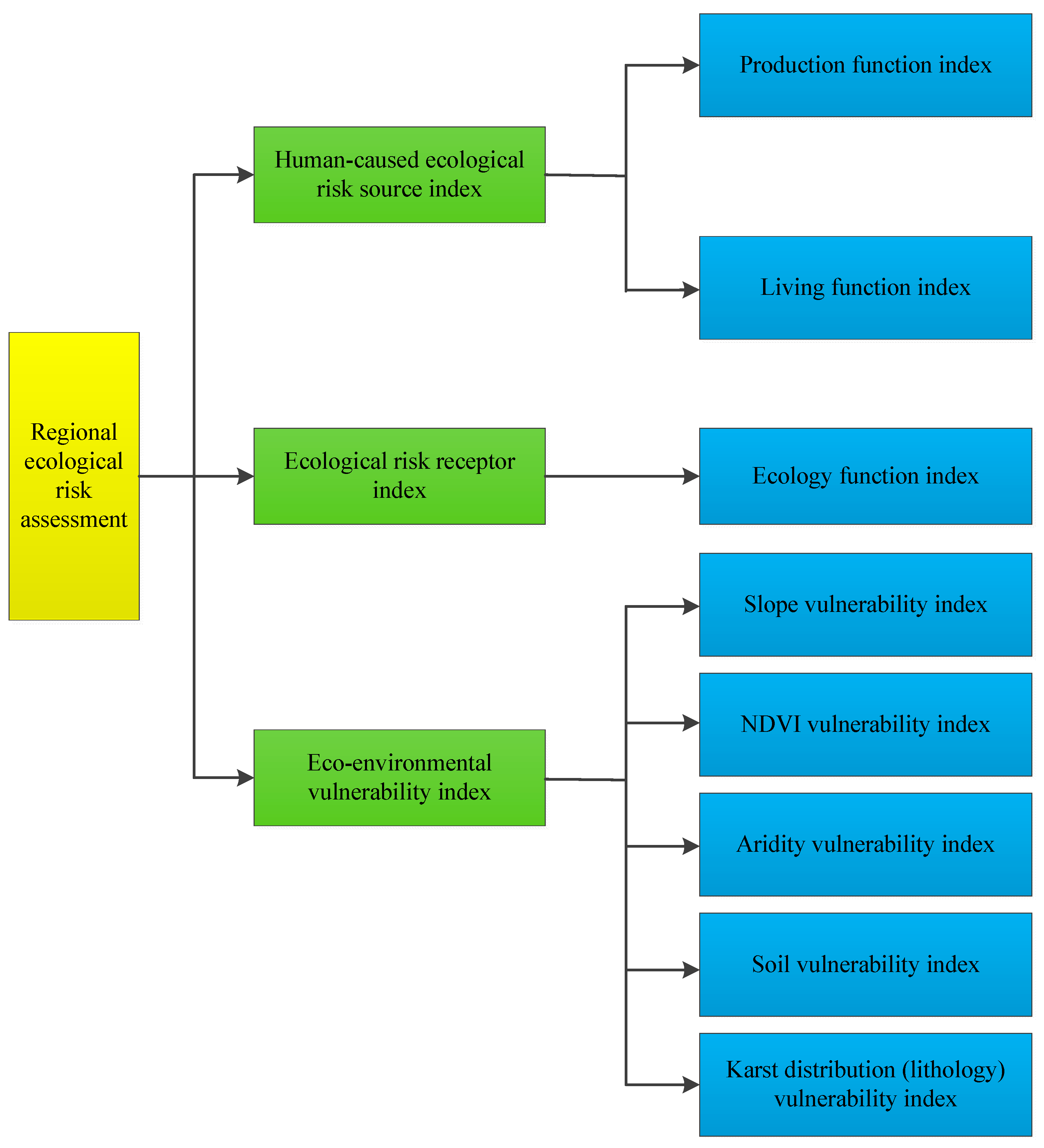
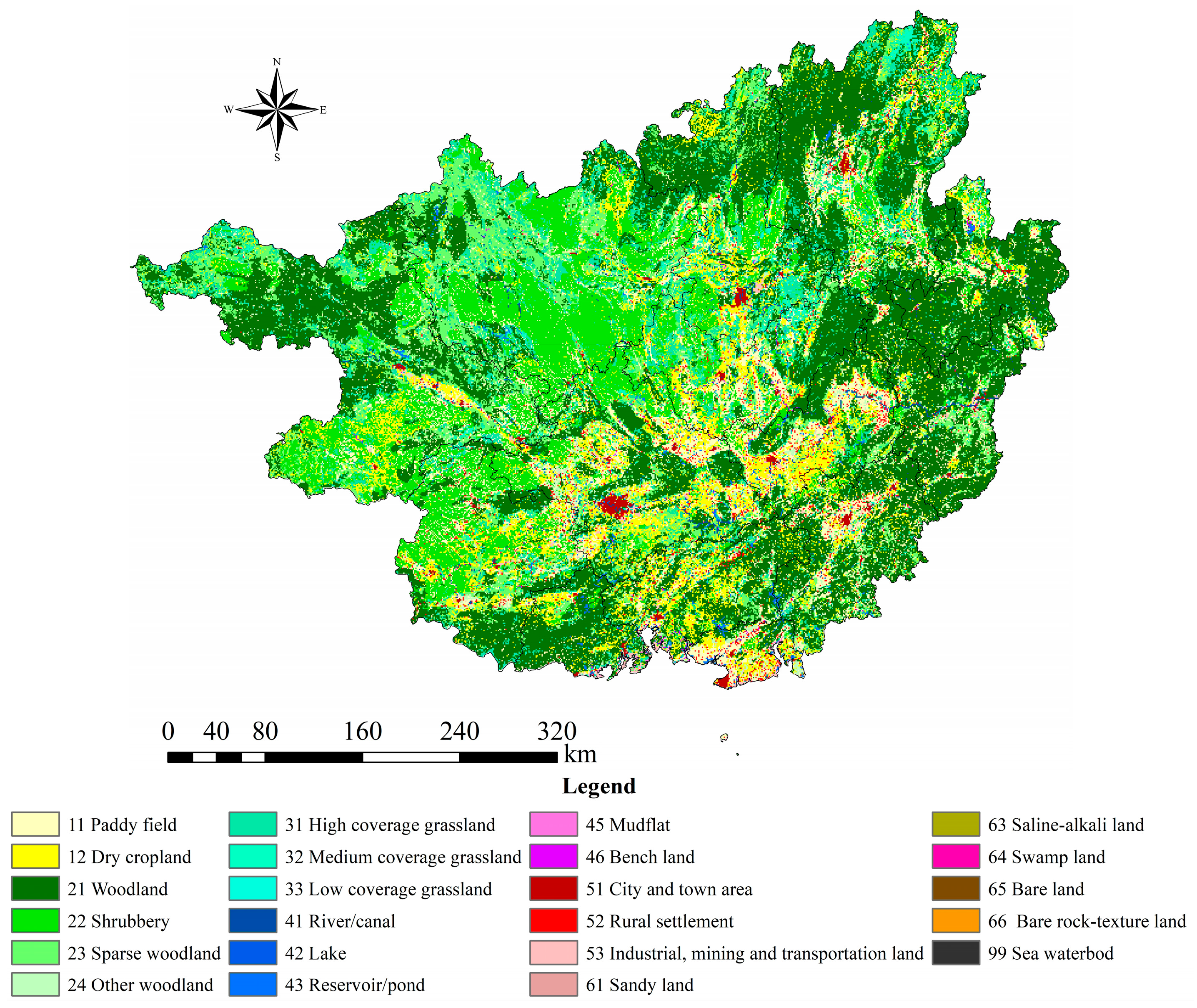
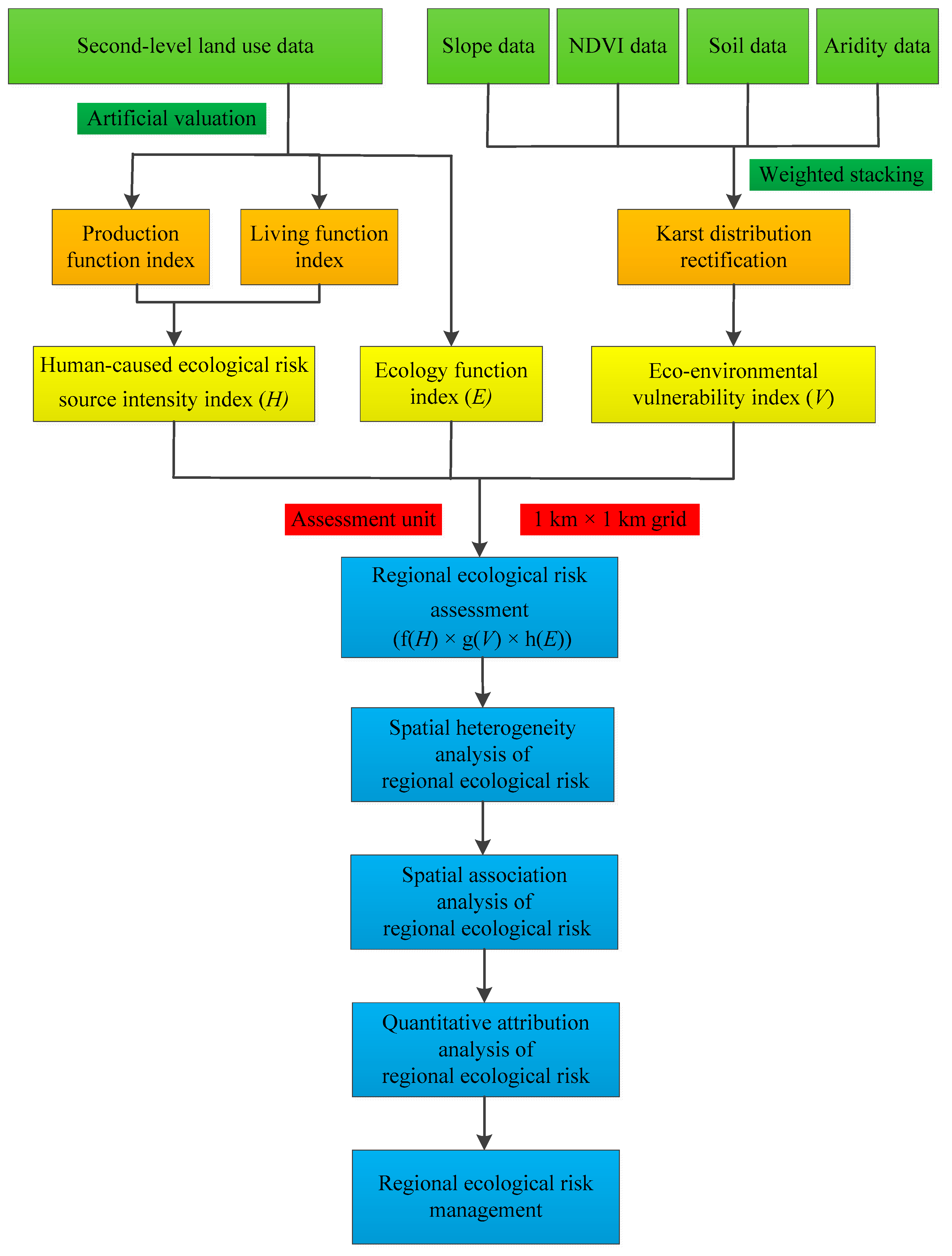
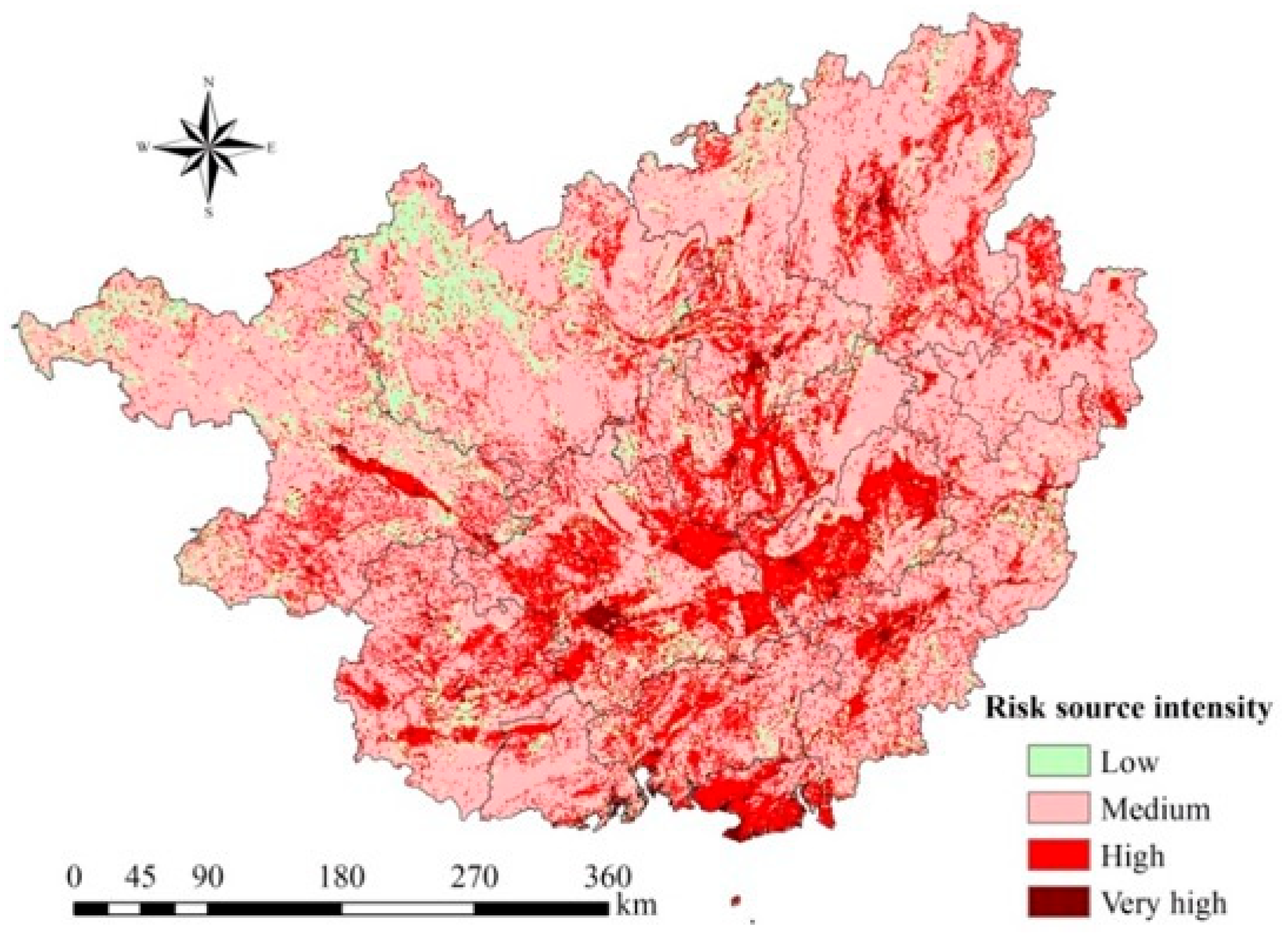

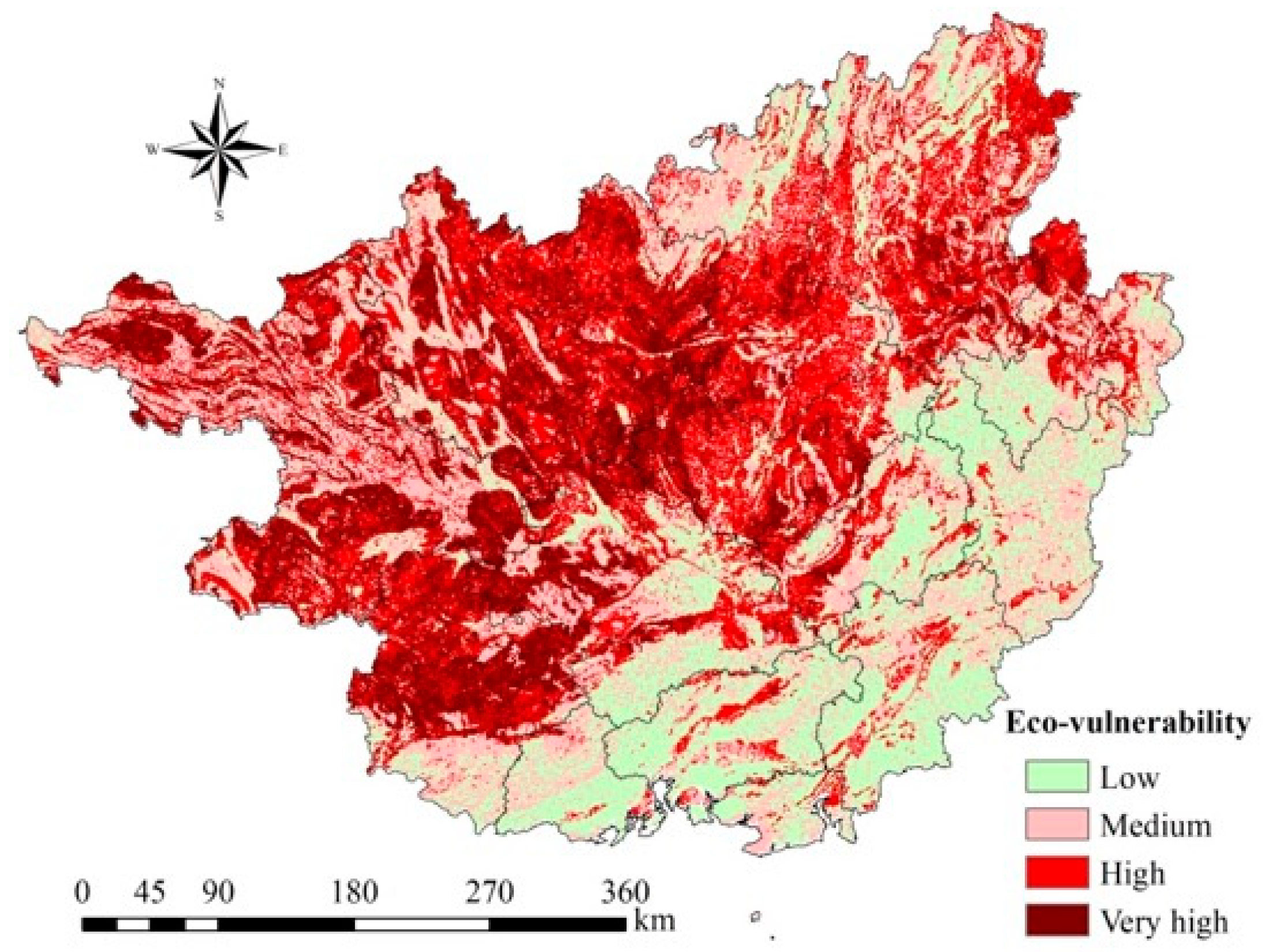
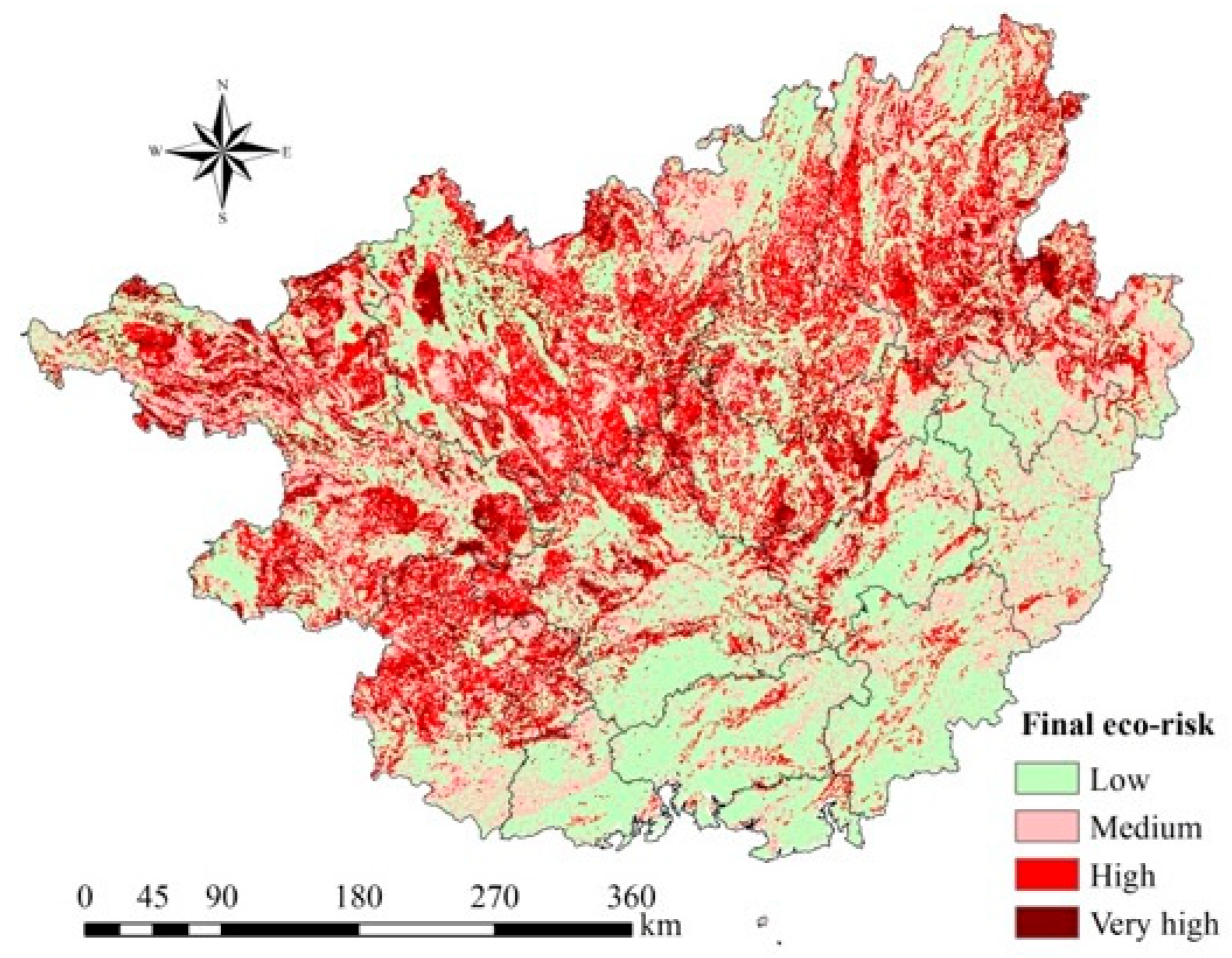
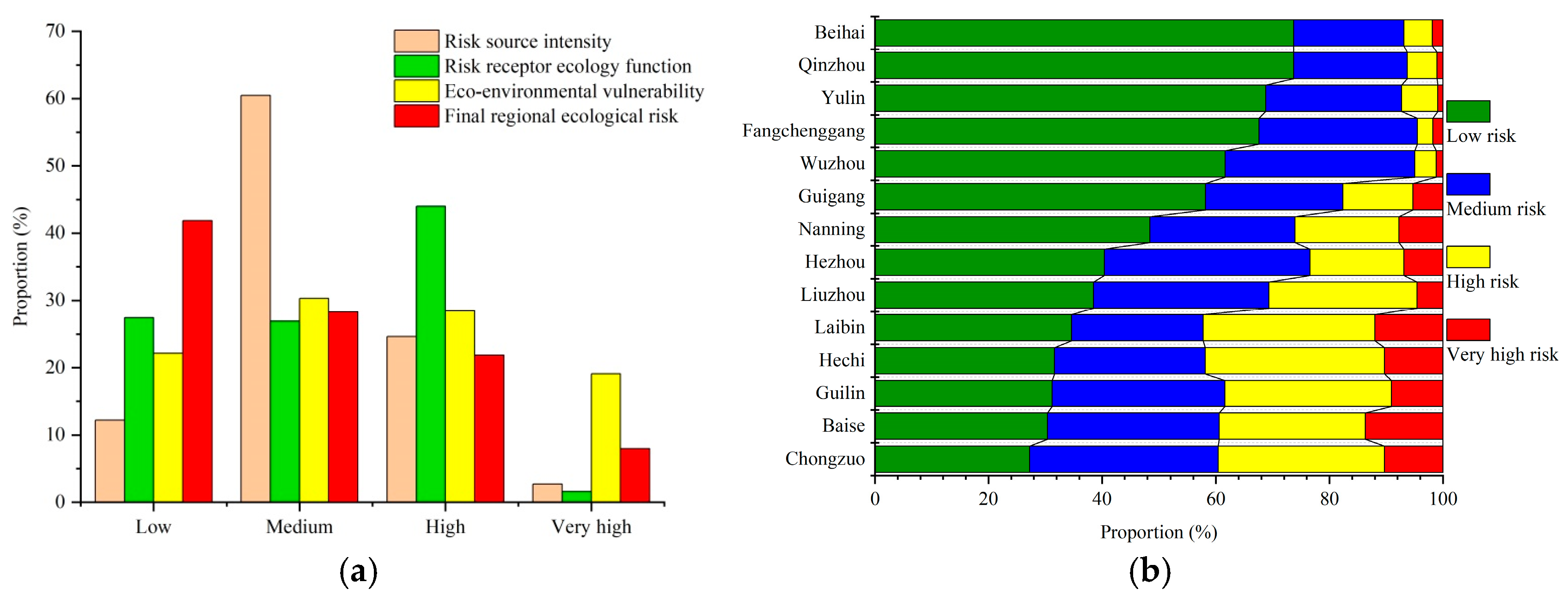

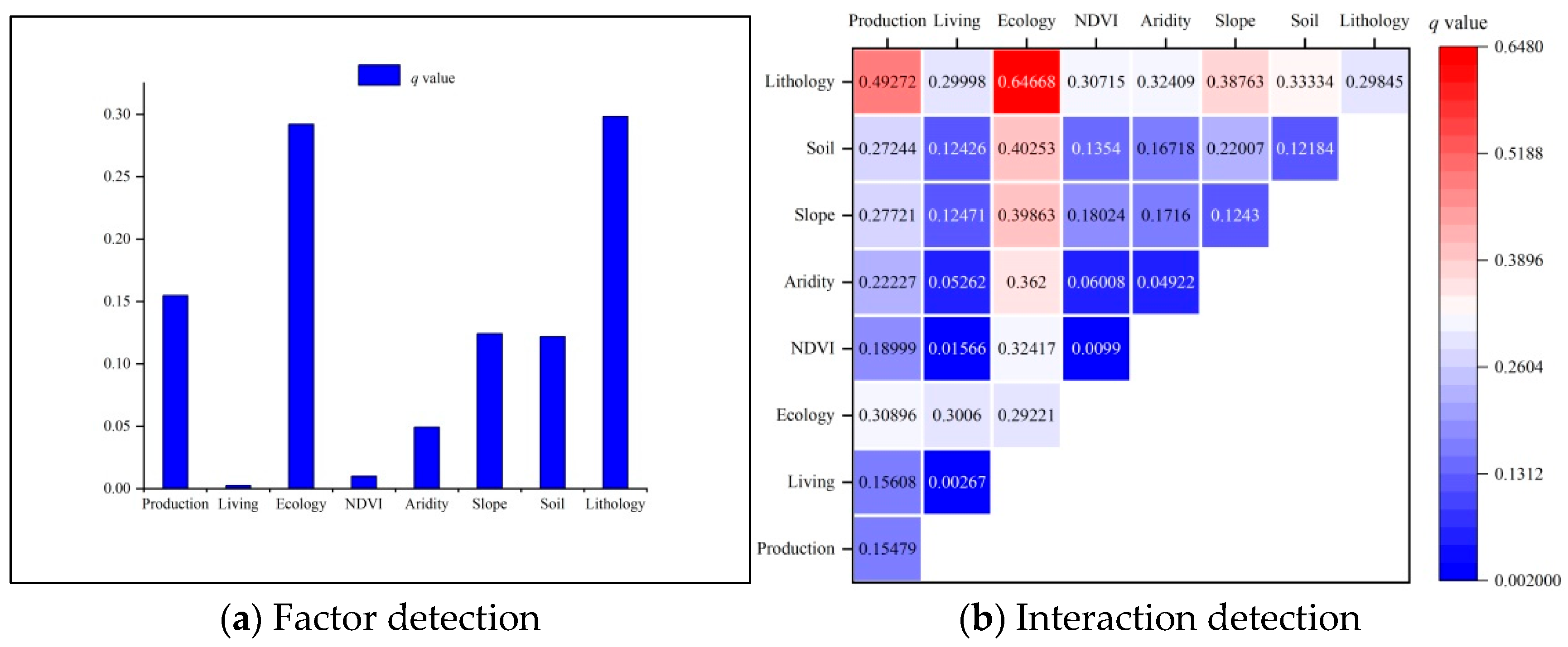
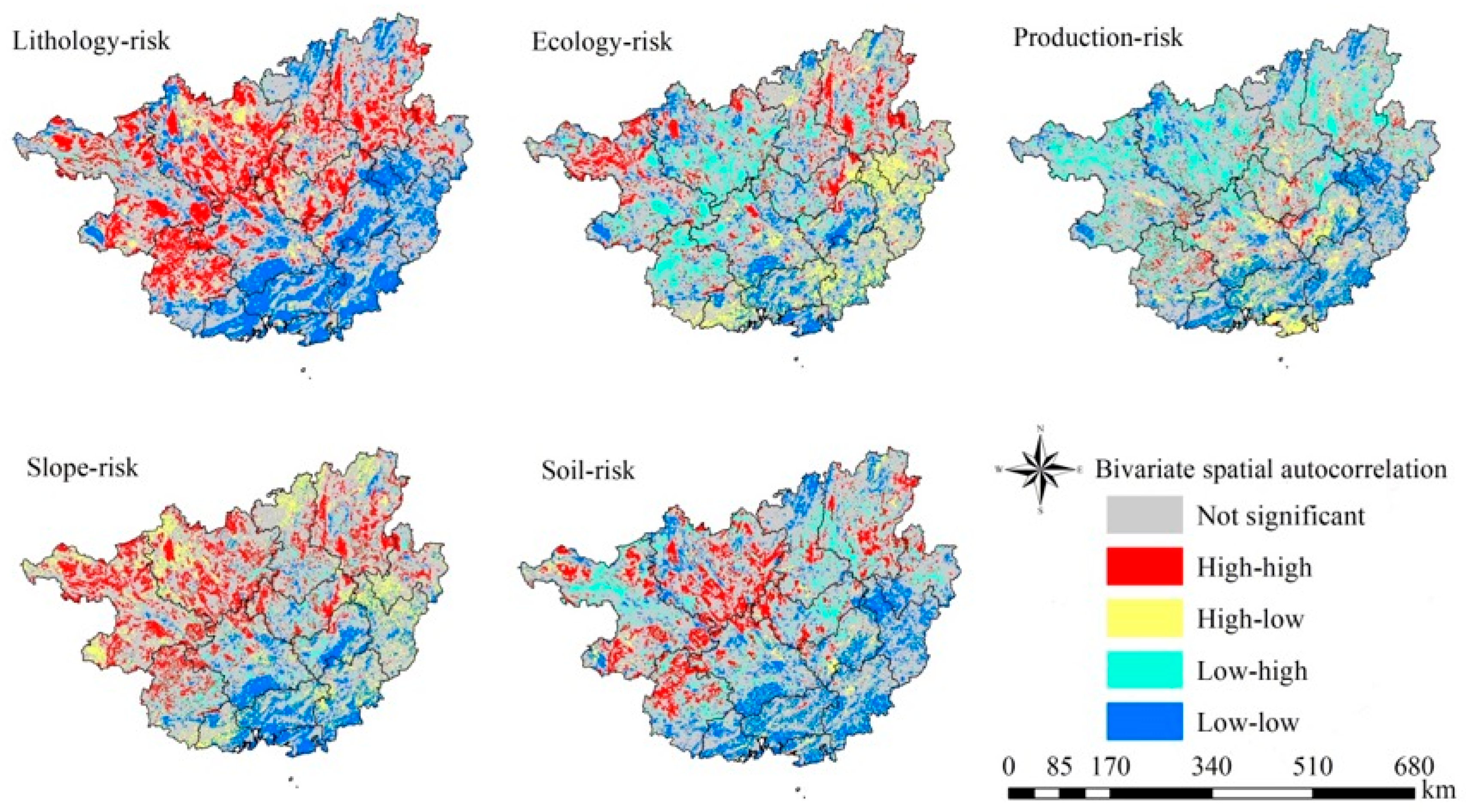
| First-Level Land Use Type | Second-Level Land Use Type | Production Function | Living Function | Ecology Function | ||
|---|---|---|---|---|---|---|
| Code | Land Use Type | Code | Land Use Type | |||
| 1 | Cropland | 11 | Paddy field | 3 | 0 | 2 |
| 12 | Dry cropland | 3 | 0 | 1 | ||
| 2 | Forestland | 21 | Woodland | 1 | 0 | 3 |
| 22 | Shrubbery | 1 | 0 | 2 | ||
| 23 | Sparse woodland | 0 | 0 | 1 | ||
| 24 | Other woodland | 2 | 0 | 1 | ||
| 3 | Grassland | 31 | High coverage grassland | 1 | 0 | 3 |
| 32 | Medium coverage grassland | 1 | 0 | 2 | ||
| 33 | Low coverage grassland | 0 | 0 | 1 | ||
| 4 | Waterbody | 41 | River/canal | 2 | 0 | 4 |
| 42 | Lake | 2 | 0 | 4 | ||
| 43 | Reservoir/pond | 2 | 0 | 4 | ||
| 45 | Mudflat | 0 | 0 | 4 | ||
| 46 | Bench land | 0 | 0 | 4 | ||
| 99 | Sea waterbody | 2 | 0 | 4 | ||
| 5 | Construction land | 51 | City and town area | 4 | 4 | 1 |
| 52 | Rural settlement | 3 | 4 | 1 | ||
| 53 | Industrial, mining and transportation land | 4 | 1 | 1 | ||
| 6 | Unused land | 61 | Sandy land | 0 | 0 | 1 |
| 63 | Saline-alkali land | 0 | 0 | 1 | ||
| 64 | Swamp land | 0 | 0 | 4 | ||
| 65 | Bare land | 0 | 0 | 1 | ||
| 66 | Bare rock-texture land | 0 | 0 | 1 | ||
| Factors | Grades Assigned | Weight | |||
|---|---|---|---|---|---|
| 1 | 2 | 3 | 4 | ||
| Slope (°) Vegetation coverage (%) | <7 >87.58 | 7–16 78.79–87.58 | 16–26 60.99–78.79 | >26 <60.99 | 0.3 0.3 |
| Soil vulnerability | Purple soil, skeleton soil, red clay, mountain meadow soil, Shajiang black soil, bare rock | Red soil, yellow soil, yellow-brown soil, laterite, lateritic red soil | Paddy soil, moisture soil | Limestone soil, volcanic ash soil | 0.2 |
| Aridity | <740 | 740–838 | 838–939 | >939 | 0.2 |
| Revised | Karst distribution area (Yes, No), Yes = 1, No = 0 | ||||
| Association Type | High-High Association | Low-Low Association | High-Low Association | Low-High Association | Not Significant |
|---|---|---|---|---|---|
| 18.09% | 19.55% | 0.91% | 1.46% | 60.00% |
| Risk Factor | Production | Living | Ecology | NDVI | Aridity | Slope | Soil | Lithology |
|---|---|---|---|---|---|---|---|---|
| q statistic | 0.15479 | 0.00267 | 0.29222 | 0.00991 | 0.04922 | 0.12431 | 0.12184 | 0.29846 |
| p value | 0.000 | 0.000 | 0.000 | 0.000 | 0.000 | 0.000 | 0.000 | 0.000 |
| Order of q | 3 | 8 | 2 | 7 | 6 | 4 | 5 | 1 |
| Production | Living | Ecology | NDVI | Aridity | Slope | Soil | Lithology | |
|---|---|---|---|---|---|---|---|---|
| Production | 0.15479 | |||||||
| Living | 0.15608 | 0.00267 | ||||||
| Ecology | 0.30896 | 0.30060 | 0.29222 | |||||
| NDVI | 0.18999 | 0.01566 | 0.32417 | 0.00991 | ||||
| Aridity | 0.22227 | 0.05262 | 0.36200 | 0.06008 | 0.04922 | |||
| Slope | 0.27721 | 0.12471 | 0.39863 | 0.18024 | 0.17160 | 0.12431 | ||
| Soil | 0.27244 | 0.12426 | 0.40253 | 0.13540 | 0.16718 | 0.22007 | 0.12184 | |
| Lithology | 0.49272 | 0.29998 | 0.64668 | 0.30715 | 0.32409 | 0.38764 | 0.33334 | 0.29846 |
| Risk Factor | Lithology | Ecology Function | Production Function | Slope | Soil |
|---|---|---|---|---|---|
| HH | 19.81% | 9.57% | 4.64% | 15.26% | 11.89% |
| LL | 19.97% | 13.43% | 15.36% | 12.71% | 18.22% |
| HL | 3.71% | 12.54% | 9.25% | 12.99% | 5.40% |
| LH | 2.38% | 13.97% | 19.49% | 7.38% | 11.79% |
| NS | 54.14% | 50.50% | 51.27% | 51.67% | 52.70% |
Disclaimer/Publisher’s Note: The statements, opinions and data contained in all publications are solely those of the individual author(s) and contributor(s) and not of MDPI and/or the editor(s). MDPI and/or the editor(s) disclaim responsibility for any injury to people or property resulting from any ideas, methods, instructions or products referred to in the content. |
© 2025 by the author. Licensee MDPI, Basel, Switzerland. This article is an open access article distributed under the terms and conditions of the Creative Commons Attribution (CC BY) license (https://creativecommons.org/licenses/by/4.0/).
Share and Cite
Wang, H. Spatial Association and Quantitative Attribution of Regional Ecological Risk: A Case Study of Guangxi, China. Sustainability 2025, 17, 8739. https://doi.org/10.3390/su17198739
Wang H. Spatial Association and Quantitative Attribution of Regional Ecological Risk: A Case Study of Guangxi, China. Sustainability. 2025; 17(19):8739. https://doi.org/10.3390/su17198739
Chicago/Turabian StyleWang, Hui. 2025. "Spatial Association and Quantitative Attribution of Regional Ecological Risk: A Case Study of Guangxi, China" Sustainability 17, no. 19: 8739. https://doi.org/10.3390/su17198739
APA StyleWang, H. (2025). Spatial Association and Quantitative Attribution of Regional Ecological Risk: A Case Study of Guangxi, China. Sustainability, 17(19), 8739. https://doi.org/10.3390/su17198739







